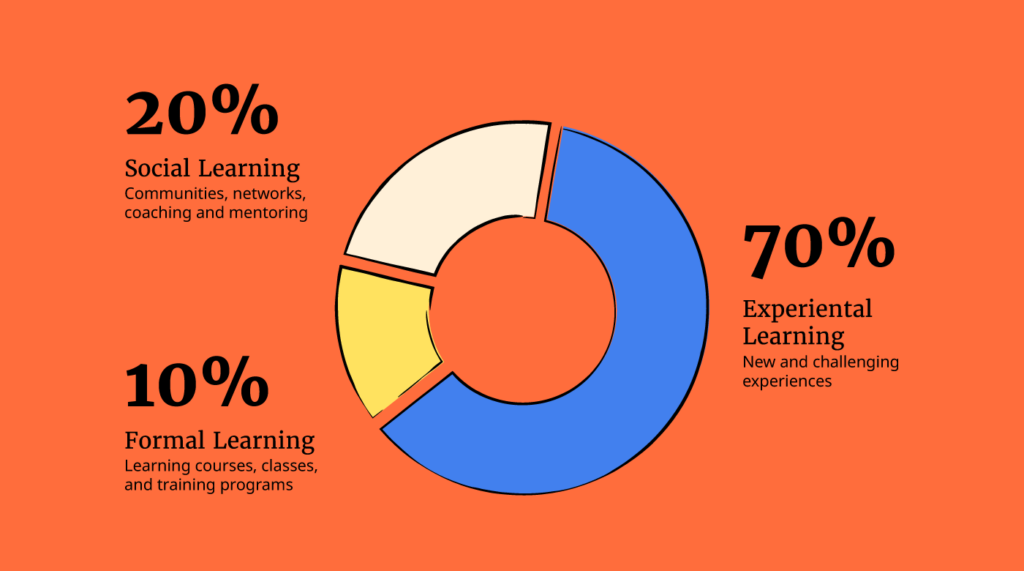Mentorship programs are a popular way to invest in talent and help organizations be more successful.
Yet, despite the benefits of these programs, research has shown that only 37% of employees cite having a mentor. Beyond this, it’s often unclear whether these programs are truly adding value or if they’ve simply become checkboxing activities.
As a leader of people, I believe that providing mentorship to others is one of the most important things I do.
Here I’ll take you through the benefits of a mentorship program and how to establish one in your organization.
What is a mentorship program?
Mentorship programs are an organized approach to matching an employee with a (usually) more senior colleague who will act as a trusted coach or adviser and support their growth and professional development.
Mentorship programs are all about taking a highly intentional approach to building human connections at your organization. Mentees gain the ability to develop critical knowledge, skills, and abilities through the coaching and guidance of their mentors.
You may have heard of the 70-20-10 Model of learning and development for building a learning and development strategy.
In this model, 70% of the way you develop your employees should be through experiential learning, 20% should be through social learning and 10% should be through formal.
Mentorship is a significant element of any well-constructed colleague and leadership development program, tying nicely with the social learning component of your overall learning and development strategy.

How can a mentorship program benefit your organization?
Mentorship programs provide many benefits to both your organization and your employees, including both mentees and mentors.
Support colleague development
Through mentorship programs, your employees can learn and grow, whether the mentor or mentee.
Mentees benefit by:
- Gaining a deeper understanding of their strengths and opportunity areas
- Getting advice/feedback/perspective from other colleagues in a psychologically safe environment
- Gaining new skills, new perspectives, new relationships/partnerships around the organization, and a greater sense of belonging in your organization
- Better understand the makeup of the organization (this is especially beneficial for newer colleagues and/or colleagues at complex organizations that can be hard to navigate).
- Gaining life skills that can benefit them even beyond the workplace
- Feeling more empowered to realize their career goals.
Mentors benefit by:
- Developing their coaching skills and playing a different role than they might in their daily work
- Gaining new perspectives and relationships with employees around the organization
- Potentially building succession plans and helping ensure that their knowledge, skills, and abilities are passed onto the next generation of talent.
Better internal mobility and succession slates
As organizations across the globe battle for top talent, it’s vital that they’re able to build slates of talent ready to be deployed as new opportunities emerge around your organization.
According to the Harvard Business Review, investing in your colleagues through mentorship has “a host of professional benefits, including more rapid advancement, higher salaries, greater organizational commitment, stronger identity, and higher satisfaction with both job and career.”
Your employees benefit by gaining a network of advocates who can help them navigate the organization, be a sounding board and coach through challenges, and ensure they’re focused on honing the key strengths needed to further their career goals.
Develop diverse talent pools
The networking and mentoring partnerships built across your organization via mentorship can also play a significant role in supporting your diversity, equity, and inclusion efforts.
Mentorship helps to organically spread diverse perspectives across your organization by allowing mentors and mentees to learn from each other and embrace the highly diverse makeup of your company.
Further, many organizations use mentorship programs to invest specifically in underrepresented demographics within your organization.
This can help you build a pipeline of diverse talent ready to take on new challenges within your company and help ensure your leadership team is representative of both your employee population and the communities in which you live and serve.
Enhanced workplace culture and employee engagement
Ultimately all of these benefits boil down to building a better work experience for your people and increased employee engagement and retention for your organization.
In today’s highly complex world of work, professional development is listed as the highest-priority investment that employers can make to improve company culture, and mentorship should be included as a critical part of any comprehensive effort to develop your people.
Types Of Mentorship Programs
- Traditional one-on-one mentorship. This is the most common form where an experienced employee (mentor) is paired with a less experienced colleague (mentee) to provide individual guidance and support in their professional development.
- Group mentorship. In this model, a single mentor or a group of mentors works with multiple mentees. This approach can be beneficial for workshops or training sessions where a collective learning experience is desired.
- Peer-to-peer mentorship. This involves employees of similar job levels or roles mentoring each other. It's particularly effective for sharing specific job-related skills or knowledge.
- Reverse mentorship. Younger or less experienced employees mentor senior staff, often to share knowledge in areas like technology, digital trends, or emerging market behaviors.
- Leadership or executive mentorship. Aimed at grooming high-potential employees for leadership roles, this type of mentorship pairs them with experienced leaders or executives within the organization.
- Onboarding mentorship. New employees are paired with mentors to help them acclimate to the company culture, understand company processes, and integrate more quickly and effectively into their new roles.
How to start a mentorship program in your organization

1. Revisit your talent priorities
Like all strategic human resources initiatives, building a workplace mentorship program starts first and foremost with your talent priorities.
Before designing your program, you should revisit your organization's talent management philosophy and get a better understanding of how the journey you’ll be embarking on will be docked into your strategic talent goals.
Consider what it is that you’re trying to accomplish through your mentorship program and how your mentorship program will contribute to your strategy.
This will help define the guardrails or ‘bumpers’ that you use during the design phase, and ensure all of your programmatic efforts are working synergistically towards creating a great employee experience.
2. Design your program
Designing your program starts with a simple question: “What do you want your employee mentorship program experience to be like?”.
There’s no wrong answer to this question, except perhaps on a few points (see 2.5 Differentiating Design Factors section below).
Consider the following questions for each of your key design decisions.
2.1 Define Your Audience
- Who do you want your mentoring program to support?
- Are there specific demographics we are working to impact via our DE&I initiatives?
- Who needs mentoring the most? Executives? Leaders of people? Future leaders of people? Individual contributors? New hires? Young people/early in career? High-potential talent?
- Are there specific segments of your business that are at risk of losing talent?
- Should mentorship be a required activity or something your employees opt into?
2.2 Program enrollment
- How will your employees enroll in the program? Can employees opt-in on their own or does their leader need to be involved in the process?
- Are there similar programs at your organization that you can lean on for inspiration? Is there a specific tool that is commonly used at your organization that you can use?
- Do we need to acquire mentoring software to support the mentorship process?
- When should your employees enroll in the mentorship program? When they are hired? Annually? Bi-annually? Whenever they’re ready?
2.3 Define responsibilities
- What are the specific expectations of both your mentors and your mentees? What types of mentoring are you trying to provide(technical, leadership, etc.)?
- Do your mentors have the competencies and skills needed to provide quality mentorship to your program participants? Is there training needed to enable your mentors? Should some colleagues not be allowed to participate as mentors (too new to the organization, on a performance improvement plan, etc.)?
- How will you match your mentors to your mentees? Will it be randomized or based on other criteria? Will you offer group mentoring or individual?
- What does the future of work look like at your organization? Are there key competencies and leadership skills that need to be a focus of your program?
- What types of topics should be covered? Does the mentor/mentee have the latitude to define this, are they provided with a repository of topics to discuss or will this be driven centrally (i.e., monthly topics, webinars, etc.)?
2.4 Mitigating potential challenges
Part of designing your program must include a proactive look at what might potentially derail your mentorship experience.
I’d start by examining what hindered the success of other programs at your organization. Beyond this, consider how you might address the following common challenges:
- Having more mentees than mentors
- Mentors/mentees not meshing well
- Performance challenges and someone using this as an excuse to not work
- A mentor/mentee leaves the organization leaving the other without their mentor/mentee
- Ensuring that people are utilizing the program effectively
- Mid-level managers do not give employees sufficient time to focus on the mentoring program.
2.5 Differentiating design factors
As I mentioned earlier in this article, mentorship programs are becoming increasingly common. Your organization might already even have one. So how do you go about making sure that it’s as effective as possible?
Consider the following differentiating best practices when designing your program:
People come first
I’m a huge proponent of involving your employees in the design process for all HR solutions. For a great mentorship program, this isn’t optional—your people need to be at the center of the design process. If your program doesn’t meet their needs, they’ll never adopt your program.
There are a few ways you can go about this. A more formal approach would be to leverage human-centered design experts to help support your process.
However, simpler approaches like surveys, focus groups, and listening sessions are all practical ways to ensure you’re leveraging the voice of your colleagues to create the best possible mentorship program for them.
Minimize “marginal mentoring”
The Harvard Business Review points out that “if there is a single, consistent Achilles heel in organizational mentoring structures, it is marginal mentoring.” Marginal mentoring (or mediocre/ineffective mentoring) can actually be worse than not mentoring employees at all.
The plague of poor mentoring can stem from many sources. One of the major culprits comes down to aptitude—do your people have the right power skills to be strong mentors?
Strong mentors are great listeners, communicators, givers of feedback, and networkers.
If your mentors do not have these abilities, you must provide them with the tools and resources to upskill in this space before you let them loose on their mentees.
Another common pitfall is simply time. If your mentors and mentees aren’t given sufficient time within their day-to-day bandwidth, they simply won't execute the expectations of your program.
Make your program mandatory
Studies have found that mentorship programs provide the most value if they’re mandatory.
The risk of voluntary programs is that, often, the employees who need the most peer mentoring are often the ones who opt out of taking advantage of your program.
Requiring mentorship helps ensure that none of your employees are left behind. This is especially critical when you’re leveraging your program to impact your DEI goals.
Beyond this, mandatory mentorship helps solve the ‘marginal mentoring’ problem. Required work comes with performance expectations.
This means your mentors and mentees are held accountable for the work they do in this space, are given regular coaching and feedback to ensure their performance is adequate, and are given sufficient time within their workload to contribute to your mentorship program.
Automate, automate, automate
It seems like we are looking everywhere these days for systems, processes, and tools to automate. Mentoring programs are a perfect candidate for automation.
Depending on the size and scale of your company and your mentoring experience, mentoring programs can create a significant amount of manual effort that would highly benefit from an HR tech solution to help minimize this workload and streamline the experience for your participants.
Mentoring solutions, often found in technology solutions like talent marketplaces, can leverage artificial intelligence or specific algorithms to connect your mentors and mentees based on their unique competencies, strengths, and opportunities.
This helps minimize the oversight needed for your program while ensuring the highest quality of matches between your mentors and mentees.
3. Develop Tools and Resources
The development of your program is going to be based closely on the key decisions of your design process. This may include the implementation of new mentoring software or other new tools to help manage your program.
Additionally, you’ll also need to develop all the tools and resources your program participants will need to be successful. Examples might include:
- Program Guide
- Roles and Responsibilities Overview
- Job Aid - How to Be an Effective Mentor
- Job Aid - How to Be an Effective Mentee
- Job Aid - How to Build an Individual Development Plan (IDP)
- Job Aid - How to Begin the Mentee/Mentor Relationship
- Job Aid - How to Conclude the Mentee/Mentor Relationship
- FAQs.
4. Build a communication plan
Implementing a successful mentoring program is no small task. This could be a major change for your organization, especially if certain employee groups are required to engage in the program.
It’s important that you develop a well-thought-out change management process and build a communication plan designed to drive adoption.
This plan should consider all key audiences who need to learn about the new mentorship program and help ensure they receive all the information they need every step of the way.
This is also your opportunity to market the benefits of your program, the value it will drive for both employees and the organization, and help employees see the investment you’re making in their personal growth and career development.
5. Call for participants and matching mentors and mentees
This is probably the most exciting part—soliciting participants for your program! Once you’ve thoroughly communicated the intention of the program, you can move forward with identifying participants for the program.
During your design phase, you will have identified how you will match mentors and mentees together. There are a couple of factors that I recommend that you try to balance here:
- Generally, you want to ensure that you’re connecting mentees to mentors outside of their team/business unit. This allows your participants to better contextualize how the work they’re doing contributes to your overall organizational imperatives as well as giving them a broader understanding of the business.
- What competencies and skills do your mentors have that your mentees need? Matching junior employees with more senior-level colleagues, with strong subject matter areas in which they’re trying to grow and develop, helps ensure your participants will get the most skill-building out of the experience.
6. Evaluate success and adjust your approach
All products, programs, and services that you provide to your employees should be iterative and mentorship programs are no exception to this rule.
It’s always tempting to jump directly into your next big idea to deliver more opportunities for your people, but your mentorship program will have been a major investment in your colleagues and you want to ensure you are getting positive outcomes out of your investment.
The design of your program and what goals you set out to achieve will influence your approach here.
Your mentorship program needs to have a plan for ongoing maintenance, the collection of feedback, and the implementation of tweaks and enhancements to ensure it remains successful over time.
Your Mentorship Program Can Help Differentiate Your Org
Mentorship programs can be a differentiator in how you develop, retain, and engage your talent—but only if done in the right way.
Whether you’re building a brand new program or trying to upgrade an existing one, you can leverage the best practices detailed in this article to ensure you provide your employees with an amazing mentoring program experience.
Join The People Managing People Community
For further advice on implementing mentoring programs in your org, join our supportive community of HR and business leaders sharing knowledge and expertise to help you progress in your career and make greater impact in your organization.


